2.19 Monero: Where Cryptocurrency Meets Cryptography
Free Airdrop Season 7 is LIVE! Answer fun questions or do simple tasks to earn rewards from the $30K BitDegree prize pool. Participate Now ! 🔥
In this section, we’re going to take a look at one of the stealthiest cryptos out there, and answer the questions of “What is Monero coin?” and “How does Monero work?”.
Monero is where “Cryptocurrency” meets “Cryptography.” It’s a privacy-focused crypto coin that prioritizes different objectives than your usual crypto assets. By providing a laser-sharp focus on the importance of anonymity, Monero gained momentum and a following of those who have no doubts about the importance of such aspects when it comes to blockchains and cryptocurrencies.
But, by doing so, Monero found itself in the middle of a crossfire. On the one hand, highlighting the importance of anonymity sounds like a non-compromising dedication to protecting user privacy and their data. On the other hand, it’s exactly what criminals want.
In this section, we’re going to look into the questions of “What is Monero coin?”, “What is XMR coin?”, and “What does XMR DeFi look like?”. Understanding this will allow you to see what is Monero used for, and why it’s popular among people with malicious intentions as well.
Well, let’s wait no more and get straight to the point.

Video Explainer
Video Explainer: Monero: Where Cryptocurrency Meets Cryptography
Reading is not your thing? Watch the "Monero: Where Cryptocurrency Meets Cryptography" video explainer
What is Monero? XMR Animated Explainer
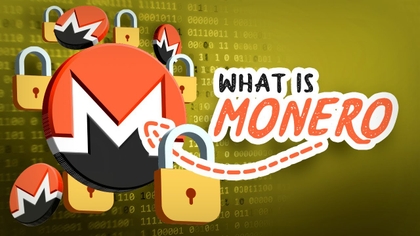

What is Monero (XMR?)
When it comes to cryptocurrencies, Monero is the one that’s all dressed in camouflage. It’s the coin where anonymity and privacy reign supreme. Similar to Bitcoin in its decentralized nature, Monero takes anonymity to a whole new level, establishing itself as the go-to choice for those valuing discretion. But to truly answer the question of “What is Monero coin?”, we have to take a look at this project’s history.
The origins of Monero trace back to a moment in 2012 with the release of the CryptoNote whitepaper. Authored by the enigmatic developer known only as Nicolas van Saberhagen, this cryptocurrency research paper unveiled revolutionary cryptographic techniques and introduced a novel electronic cash concept called "CryptoNote."
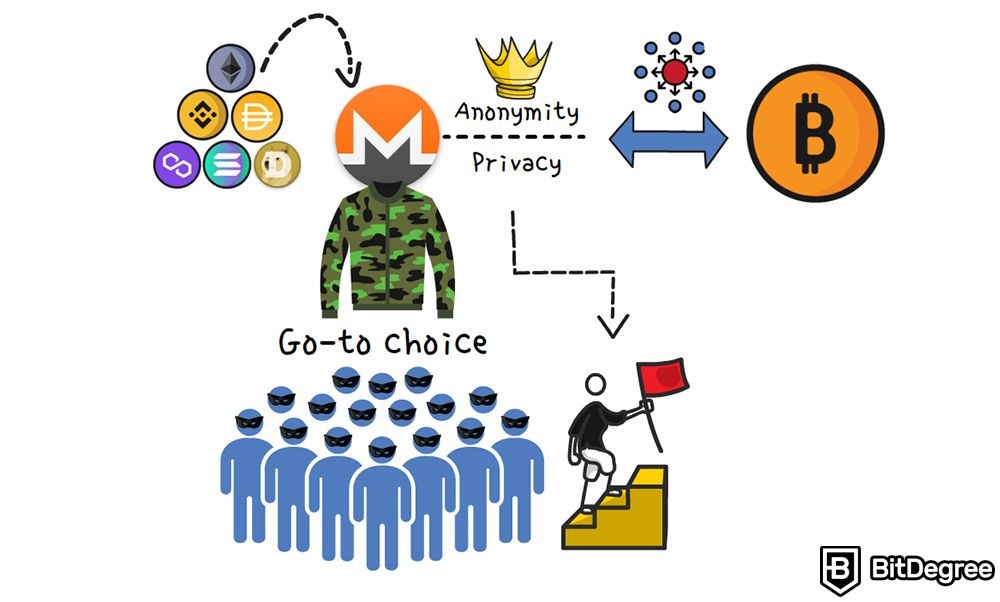
Taking a bold leap from theory to reality, Bytecoin became the first cryptocurrency to implement the CryptoNote protocol. But the story didn't end there. In 2014, Bytecoin's codebase experienced a fork, birthing a brand-new currency known as Bitmonero. Over time, Bitmonero transformed into the Monero that we know today.
By the way, a fork in crypto refers to the process where a blockchain splits into two separate chains, creating a new version of the original cryptocurrency. That’s how Monero was born!
What’s interesting about Monero, is the fact that everything that’s Monero-related is at least somehow shrouded in the mist of anonymity. Unlike most conventional cryptocurrencies, Monero has no single founder or CEO at the top of the project. Instead, a core team of developers is responsible for the creation of it. And, no surprises, most of them chose to remain incognito.
Among the few known names is Riccardo Spagni, known as FluffyPony. For years, he led Monero's development before stepping down in December 2019.
As an open-source endeavor, Monero relies on the support of its community. Thousands of dedicated individuals worldwide have contributed to the project's growth through Monero's Community Crowdfunding System (CCS), ensuring this privacy-oriented cryptocurrency does not fade away because of a sudden lack of resources.

But understanding the answer to the question of “What is Monero coin?” requires taking a look at why this coin gained popularity as time passed. And, of course, it all comes down to privacy and how Monero approaches it.
With traditional cryptocurrencies, like Bitcoin, users have public addresses where transactions can be traced back and linked. The recipient's address is exposed to the sender, revealing the number of coins they hold, and all transfers are recorded and made public on the blockchain.
But here's where Monero saw an opportunity and grabbed it. They realized that this is not ideal. When you transact with Monero, you don't get an all-access pass to the recipient's holdings, even if you have their public address. Monero's transactions are cleverly designed to be unlinkable and untraceable. Each coin sent to a recipient takes a detour through a randomly generated address, tailored exclusively for that transaction.
Unlike traditional blockchains, Monero's ledger doesn't reveal the true sender and recipient's stealth addresses. The one-time address created for each transaction remains disconnected from the parties' actual addresses, leaving no footsteps for curious online sleuths and detectives to follow. The result? Complete confidentiality for all past and present transactions within the Monero network.
Now, let’s take a deeper look at how does Monero work, because, as you can see, it’s what makes it so different.
How Does Monero Do It?
Monero uses three innovative technological solutions. They’re called ring signatures, stealth addresses, and confidential transactions. Here's a brief rundown of each element.
Ring signatures are used to hide the sender's identity. When a transaction occurs, multiple possible senders are mixed together in a "ring," making it impossible to determine which one is the actual sender. It's like a cloak of invisibility for your transaction! But hey, let’s use a more real-life example.
Imagine you and your close friends decide to send a surprise gift to someone, but you want to keep it a secret who exactly contributed to the gift. So, each of you write your name on a piece of paper and put it into a hat. Then, one of your friends takes out all the pieces of paper, shuffles them, and randomly picks one piece without looking at it.
The name on the chosen paper becomes the "signature" on the gift. Even though everyone contributed, no one knows who specifically gave what, maintaining the surprise and secrecy. Ring signatures work similarly by mixing multiple senders' signatures, making it impossible to tell who exactly sent the transaction.
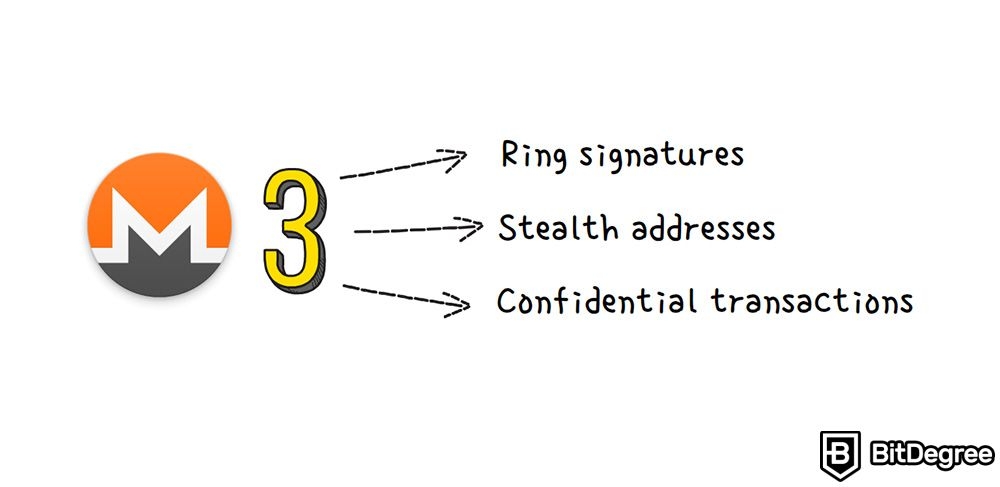
With stealth addresses, the recipient's public address is obscured. Each transaction generates a one-time address for the recipient, keeping their identity hidden from possible external, unrelated onlookers.
Think of stealth addresses as a temporary forwarding address for your mail. Let's say you're a YouTuber, and you want to open your P.O. Box for the viewers, so they could send you gifts and stuff. Thus, you provide them with a special address that’s designated to receive parcels from strangers, but it’s not your home address.
By doing so, you remain accessible, yet you manage to keep your actual location hidden, because you don’t want to put sensitive personal data out there for anyone. Stealth addresses work similarly by generating unique, one-time addresses for each transaction, protecting the recipient's real address.
And when it comes to Confidential Transactions, Monero uses them to hide the transaction amount. It employs cryptographic methods to ensure that only the sender and recipient know how much was sent, while outsiders are left in the dark.
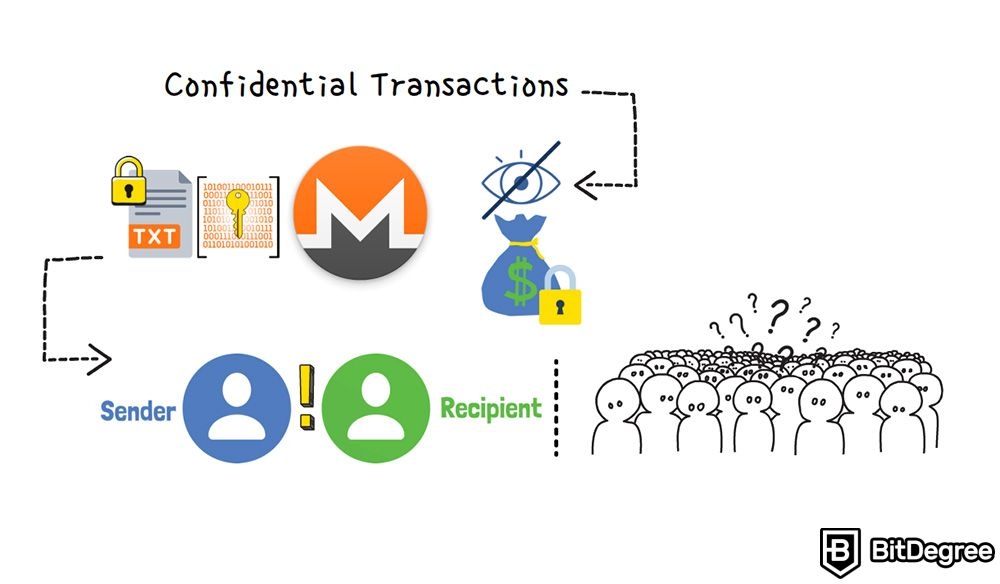
Picture a store where the price tags are covered with scratch-off material. When you buy something, the cashier removes the scratch-off to reveal the price, and you pay the amount. However, other customers in the store can't see the original price, only the final amount you paid.
This way, you can make purchases without revealing the exact price to others. Confidential transactions work similarly by hiding the exact transaction amounts, so only the sender and receiver know the actual values, while outside observers see encrypted or distorted information.
By combining these privacy features, Monero managed to take anonymity to a whole new level. No wonder it's become a top choice for privacy-conscious individuals in the crypto world! And, whether we like it or not, that’s the reason why headlines like “The Criminal Underworld Is Dropping Bitcoin for Another Currency” started popping up a few years ago.
What is XMR?
At this point, we've answered the questions of “What is Monero?” and “How does Monero work?”, but we haven’t yet touched upon the question of “What is XMR coin?”. So, let’s do that right now, since XMR is inseparable from Monero.
In its very essence, XMR is the ticker symbol for Monero. Think of XMR as the code name for Monero, just like BTC is for Bitcoin. So, whenever you hear people talking about XMR, they're referring to Monero.
Let’s address the tokenomics of XMR, the Monero token, so you have a better understanding of how this project looks when it comes to practical matters.
Monero's tokenomics are carefully designed to achieve several key objectives: maintaining scarcity and value appreciation through a capped supply, incentivizing miners through a dynamic emission rate and a tail emission mechanism, and ensuring decentralized mining through ASIC resistance.
As you can see, miners play a role within Monero’s ecosystem, because it runs on a variant of the Proof-of-Work algorithm.
To learn more about PoW, be sure to check out this section.
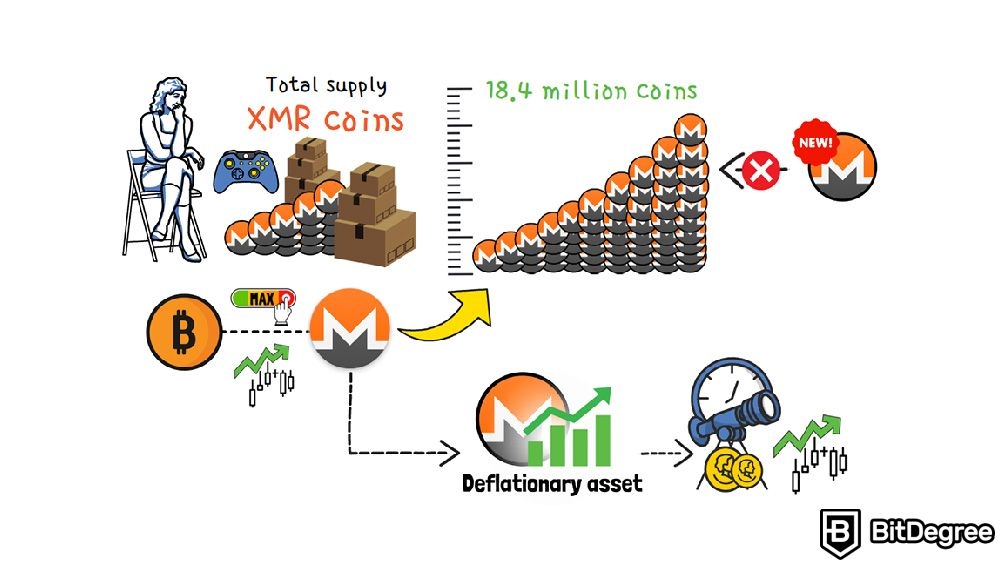
So, the combination of these said features aims to strike a balance between rewarding early participants and securing the network's long-term sustainability. Monero's approach to tokenomics contributes to its appeal as a privacy-focused cryptocurrency.
The question of Monero's tokenomics begins with the total supply of XMR coins. Similar to Bitcoin, Monero has a capped supply to ensure scarcity and value retention. The total supply of XMR is capped at approximately 18.4 million coins. This means that once this number is reached, no new XMR coins will be created. The controlled supply makes Monero a deflationary asset, which may contribute to its potential long-term value appreciation.
Monero's emission rate was designed to ensure a fair distribution of coins over time. In the early days of Monero, the emission rate was higher, gradually decreasing as the network matured. This approach helped incentivize early adopters, including miners, while also ensuring that XMR doesn't flood the market all at once, which could adversely affect its value.
The emission rate decreased smoothly until it eventually ended in 2022, when the last coin was created.
As mentioned previously, Monero runs on a Proof-of-Work consensus mechanism. This means that it relies on miners. Miners use computational power to validate transactions and create new blocks on the blockchain.
Unlike some other cryptocurrencies, Monero's PoW algorithm is designed to be ASIC-resistant, meaning it aims to prevent specialized mining hardware from dominating the network. This allows for a more decentralized mining process and wider participation among individual miners.
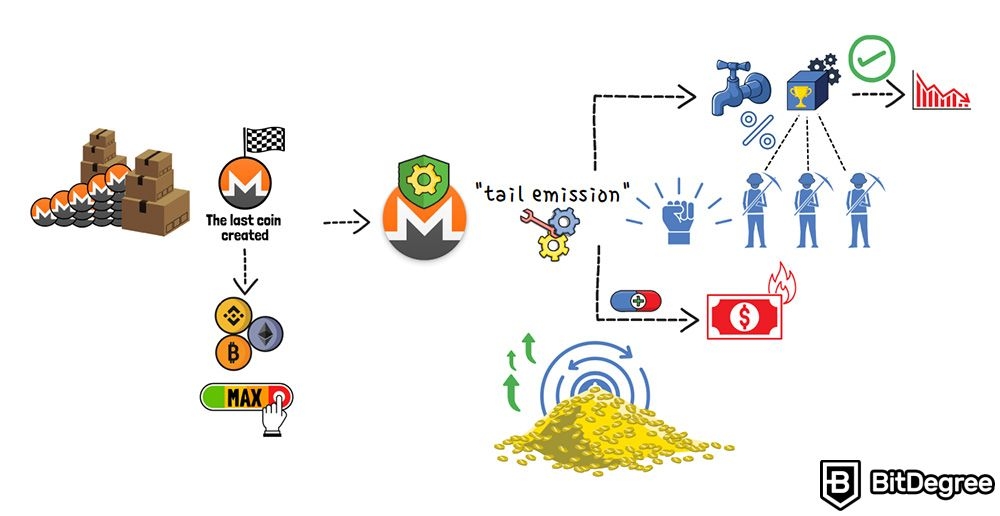
And, as it’s usually the case with PoW blockchains, as miners validate transactions and add blocks to the blockchain, they are rewarded with newly minted XMR coins. The block reward serves as an incentive for miners to participate in securing the network and maintaining its integrity. However, it's important to note that the block reward decreases over time due to the dynamic emission rate mentioned earlier.
In addition to the block reward, miners also earn transaction fees for including transactions in the blocks they mine. Transaction fees act as an additional incentive for miners and help support the network's security and operations. The fees vary depending on the size and urgency of the transaction and serve as a means to prioritize transactions in the blockchain.
There’s one more thing about Monero. As I said previously, Monero has a fixed supply, and it has already reached the point when the last coin is already mined. But there’s a twist.
Unlike some cryptocurrencies that have a fixed supply, Monero has a "tail emission" mechanism. This means that even after the maximum supply of XMR is reached, a small block reward continues to be given to miners in perpetuity.
This ensures that there is always an incentive for miners to secure the network, even when the block reward from newly minted coins becomes negligible. The tail emission also helps maintain a constant level of inflation to encourage circulation and spending of XMR.
Wrapping Up
So, by now, it’s safe to say that we have touched upon Monero DeFi and got Monero explained. We’ve answered the questions of “What is Monero coin?” and “How does Monero work?”. As you can see, when you understand what the Monero meaning is, the questions about XMR become superfluous.










